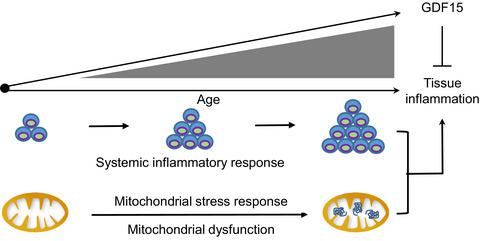当前位置:
X-MOL 学术
›
Aging Cell
›
论文详情
Our official English website, www.x-mol.net, welcomes your
feedback! (Note: you will need to create a separate account there.)
Growth differentiation factor 15 protects against the aging-mediated systemic inflammatory response in humans and mice.
Aging Cell ( IF 8.0 ) Pub Date : 2020-07-21 , DOI: 10.1111/acel.13195 Ji Sun Moon 1 , Ludger J E Goeminne 2 , Jung Tae Kim 1, 3 , Jing Wen Tian 1, 3 , Seok-Hwan Kim 4 , Ha Thi Nga 1, 3 , Seul Gi Kang 1, 3 , Baeki E Kang 5 , Jin-Seok Byun 6 , Young-Sun Lee 7 , Jae-Han Jeon 8 , Minho Shong 1, 3 , Johan Auwerx 2 , Dongryeol Ryu 5, 9, 10 , Hyon-Seung Yi 1, 3
Aging Cell ( IF 8.0 ) Pub Date : 2020-07-21 , DOI: 10.1111/acel.13195 Ji Sun Moon 1 , Ludger J E Goeminne 2 , Jung Tae Kim 1, 3 , Jing Wen Tian 1, 3 , Seok-Hwan Kim 4 , Ha Thi Nga 1, 3 , Seul Gi Kang 1, 3 , Baeki E Kang 5 , Jin-Seok Byun 6 , Young-Sun Lee 7 , Jae-Han Jeon 8 , Minho Shong 1, 3 , Johan Auwerx 2 , Dongryeol Ryu 5, 9, 10 , Hyon-Seung Yi 1, 3
Affiliation

|
Mitochondrial dysfunction is associated with aging‐mediated inflammatory responses, leading to metabolic deterioration, development of insulin resistance, and type 2 diabetes. Growth differentiation factor 15 (GDF15) is an important mitokine generated in response to mitochondrial stress and dysfunction; however, the implications of GDF15 to the aging process are poorly understood in mammals. In this study, we identified a link between mitochondrial stress‐induced GDF15 production and protection from tissue inflammation on aging in humans and mice. We observed an increase in serum levels and hepatic expression of GDF15 as well as pro‐inflammatory cytokines in elderly subjects. Circulating levels of cell‐free mitochondrial DNA were significantly higher in elderly subjects with elevated serum levels of GDF15. In the BXD mouse reference population, mice with metabolic impairments and shorter survival were found to exhibit higher hepatic Gdf15 expression. Mendelian randomization links reduced GDF15 expression in human blood to increased body weight and inflammation. GDF15 deficiency promotes tissue inflammation by increasing the activation of resident immune cells in metabolic organs, such as in the liver and adipose tissues of 20‐month‐old mice. Aging also results in more severe liver injury and hepatic fat deposition in Gdf15‐deficient mice. Although GDF15 is not required for Th17 cell differentiation and IL‐17 production in Th17 cells, GDF15 contributes to regulatory T‐cell‐mediated suppression of conventional T‐cell activation and inflammatory cytokines. Taken together, these data reveal that GDF15 is indispensable for attenuating aging‐mediated local and systemic inflammation, thereby maintaining glucose homeostasis and insulin sensitivity in humans and mice.
中文翻译:

生长分化因子 15 可保护人类和小鼠免受衰老介导的全身炎症反应。
线粒体功能障碍与衰老介导的炎症反应有关,导致代谢恶化、胰岛素抵抗的发展和 2 型糖尿病。生长分化因子 15 (GDF15) 是一种重要的线粒体因子,可应对线粒体应激和功能障碍;然而,哺乳动物对 GDF15 对衰老过程的影响知之甚少。在这项研究中,我们确定了线粒体应激诱导的 GDF15 产生与防止人和小鼠衰老时组织炎症之间的联系。我们观察到GDF15 的血清水平和肝脏表达增加以及老年受试者的促炎细胞因子。在血清 GDF15 水平升高的老年受试者中,无细胞线粒体 DNA 的循环水平显着升高。在 BXD 小鼠参考群体中,发现代谢障碍和存活时间较短的小鼠表现出更高的肝脏Gdf15表达。孟德尔随机化联系降低了人血液中GDF15 的表达,从而增加了体重和炎症。GDF15 缺乏通过增加代谢器官(例如 20 个月大小鼠的肝脏和脂肪组织)中常驻免疫细胞的激活来促进组织炎症。衰老还会导致更严重的肝损伤和Gdf15 中的肝脂肪沉积- 缺陷小鼠。尽管 GDF15 不是 Th17 细胞分化和 Th17 细胞中 IL-17 产生所必需的,但 GDF15 有助于调节性 T 细胞介导的常规 T 细胞活化和炎性细胞因子的抑制。总之,这些数据表明 GDF15 对于减轻衰老介导的局部和全身炎症是必不可少的,从而维持人和小鼠的葡萄糖稳态和胰岛素敏感性。
更新日期:2020-07-21
中文翻译:

生长分化因子 15 可保护人类和小鼠免受衰老介导的全身炎症反应。
线粒体功能障碍与衰老介导的炎症反应有关,导致代谢恶化、胰岛素抵抗的发展和 2 型糖尿病。生长分化因子 15 (GDF15) 是一种重要的线粒体因子,可应对线粒体应激和功能障碍;然而,哺乳动物对 GDF15 对衰老过程的影响知之甚少。在这项研究中,我们确定了线粒体应激诱导的 GDF15 产生与防止人和小鼠衰老时组织炎症之间的联系。我们观察到GDF15 的血清水平和肝脏表达增加以及老年受试者的促炎细胞因子。在血清 GDF15 水平升高的老年受试者中,无细胞线粒体 DNA 的循环水平显着升高。在 BXD 小鼠参考群体中,发现代谢障碍和存活时间较短的小鼠表现出更高的肝脏Gdf15表达。孟德尔随机化联系降低了人血液中GDF15 的表达,从而增加了体重和炎症。GDF15 缺乏通过增加代谢器官(例如 20 个月大小鼠的肝脏和脂肪组织)中常驻免疫细胞的激活来促进组织炎症。衰老还会导致更严重的肝损伤和Gdf15 中的肝脂肪沉积- 缺陷小鼠。尽管 GDF15 不是 Th17 细胞分化和 Th17 细胞中 IL-17 产生所必需的,但 GDF15 有助于调节性 T 细胞介导的常规 T 细胞活化和炎性细胞因子的抑制。总之,这些数据表明 GDF15 对于减轻衰老介导的局部和全身炎症是必不可少的,从而维持人和小鼠的葡萄糖稳态和胰岛素敏感性。









































 京公网安备 11010802027423号
京公网安备 11010802027423号